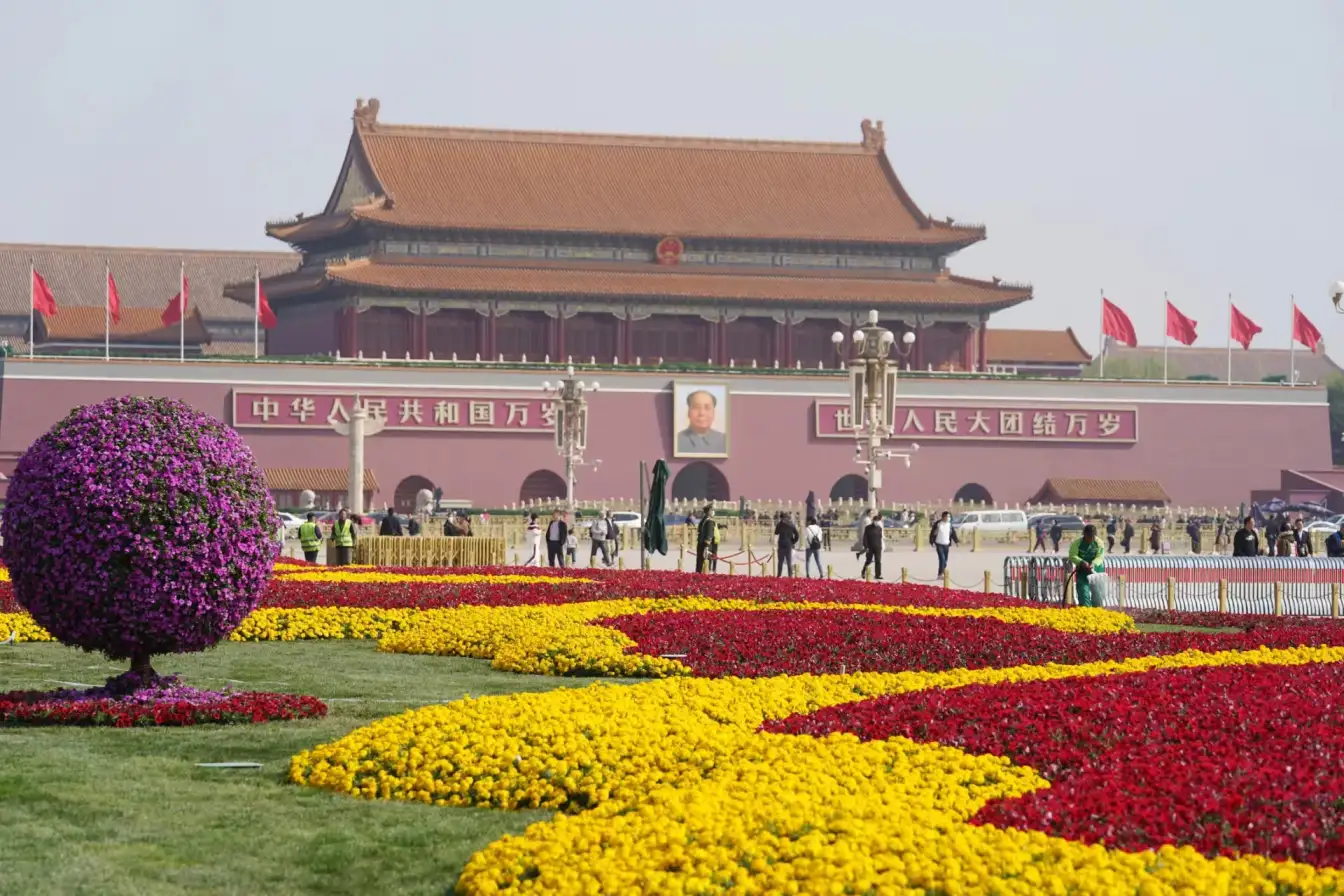
Tiananmen Square: Beijing's Iconic Landmark in China
1. Location and Overview 🏙️
Location: Tiananmen Square (天安门广场) is located in the heart of Beijing (北京), the capital city of China.
Overview: Tiananmen Square is one of the most famous landmarks in China and the largest public square in the world. It has been the site of many significant events in Chinese history and continues to be a place of cultural and political importance. Surrounded by historical and monumental buildings, the square is a symbol of China's enduring legacy and its modern developments.
2. Unique Features 🌟
- Monument to the People's Heroes (人民英雄纪念碑): A ten-story obelisk honoring those who fought for China's liberation and revolution.
- Mausoleum of Mao Zedong (毛主席纪念堂): The final resting place of Mao Zedong, the founding father of the People's Republic of China.
- Great Hall of the People (人民大会堂): The political hub where the National People's Congress convenes.
- National Museum of China (中国国家博物馆): Showcasing Chinese history and culture from ancient times to the modern era.
- Flag-Raising Ceremony: A daily patriotic ritual that draws crowds at sunrise and sunset.
3. Seasonal Changes 🌷🌞🍁❄️
Spring (March to May): Mild temperatures and blooming flowers make it a pleasant time to visit. The square is often adorned with colorful floral displays.
Summer (June to August): Hot and humid, with temperatures frequently exceeding 30°C (86°F). Be prepared for large crowds, especially during school holidays.
Autumn (September to November): The best time to visit with cool, comfortable weather and clear skies. Ideal for sightseeing and photography.
Winter (December to February): Cold and dry, with temperatures often below freezing. Fewer tourists, offering a more serene experience.
4. Best Time to Visit ⏰
The best time to visit Tiananmen Square is during autumn (September to November), when the weather is pleasant, and the skies are clear. This season provides the most comfortable conditions for exploring the square and its surrounding attractions.
5. Travel Tips 🧳✈️
- Arrive Early: To catch the flag-raising ceremony, arrive at least 30 minutes before sunrise.
- Security Checks: Be prepared for thorough security checks at all entrances.
- Dress Comfortably: Wear comfortable shoes as you will be walking a lot.
- Stay Hydrated: Bring water, especially during the hot summer months.
- Photography: Tripods are not allowed, so plan accordingly for photos.
- Guided Tours: Consider joining a guided tour for in-depth historical context and to avoid getting lost.
6. Cultural Significance 🎭🏯
Tiananmen Square holds immense cultural and political significance in China. It has been the site of numerous historical events, including the May Fourth Movement, the founding ceremony of the People's Republic of China, and the 1989 pro-democracy protests. The square is a symbol of Chinese sovereignty and national pride.
7. Tourist Attractions 📸🏞️
- Tiananmen Gate (天安门): The entrance to the Forbidden City, featuring a large portrait of Mao Zedong.
- Forbidden City (故宫): The largest ancient palatial structure in the world, home to Chinese emperors for nearly 500 years.
- Zhongshan Park (中山公园): A tranquil park with gardens and historical monuments, located adjacent to Tiananmen Square.
- Jingshan Park (景山公园): A hilltop park offering panoramic views of the Forbidden City and central Beijing.
- Qianmen Street (前门大街): A historic commercial street lined with traditional shops and eateries.
- National Centre for the Performing Arts (国家大剧院): A modern architectural marvel known as "The Egg," hosting world-class performances.
- Wangfujing Street (王府井大街): A bustling shopping street with a mix of modern stores and traditional market stalls.
- Beihai Park (北海公园): A scenic lakeside park with ancient temples and pavilions.
8. Nearby Attractions 🗺️
- Temple of Heaven (天坛): A complex of religious buildings where emperors performed rituals to ensure good harvests, located about 3 kilometers (1.9 miles) from Tiananmen Square.
- Summer Palace (颐和园): A vast ensemble of lakes, gardens, and palaces, about 15 kilometers (9.3 miles) northwest of the city center.
- Lama Temple (雍和宫): A renowned Tibetan Buddhist temple and monastery, situated approximately 5 kilometers (3.1 miles) northeast.
- Beijing Zoo (北京动物园): Home to various exotic animals, including giant pandas, located about 8 kilometers (5 miles) west.
- Houhai Lake (后海): A popular area with bars, restaurants, and historic hutongs, about 3 kilometers (1.9 miles) northwest.
9. How to Get There ✈️🚗🚂
- Air: Fly into Beijing Capital International Airport (北京首都国际机场) or Beijing Daxing International Airport (北京大兴国际机场). Both airports offer numerous international and domestic flights.
- Train: Beijing Railway Station (北京站) and Beijing South Railway Station (北京南站) connect the city with other major Chinese cities via high-speed trains.
- Subway: Take Beijing Subway Line 1 to Tiananmen East (天安门东) or Tiananmen West (天安门西) stations. The extensive subway network is convenient and efficient.
- Bus: Numerous bus routes serve Tiananmen Square. Check local schedules for specific routes.
- Taxi: Taxis are widely available, but ensure the driver uses the meter.
- Car Rental: Renting a car is possible but not recommended due to heavy traffic and limited parking. If you choose to drive, use GPS for accurate navigation.
10. Practical Information 💼💰
- Ticket Prices: Entrance to Tiananmen Square is free. Nearby attractions like the Forbidden City charge an entrance fee of approximately 60 RMB (about 9 USD).
- Opening Hours: Tiananmen Square is open 24 hours, but specific attractions like the Forbidden City are generally open from 8:30 AM to 5:00 PM. Check individual attraction timings.
- Free Entry: Some museums and parks offer free entry on certain days; check ahead for details.
- Audio Guides: Available for rent at many attractions, providing detailed information in multiple languages.
11. Local Cuisine 🍲🥢
- Peking Duck (北京烤鸭): Crispy roasted duck served with pancakes, scallions, and sweet bean sauce.
- Jiaozi (饺子): Chinese dumplings filled with meat and vegetables, a staple in Chinese cuisine.
- Zha Jiang Mian (炸酱面): Noodles topped with a savory soybean paste sauce.
- Hot Pot (火锅): A communal meal where diners cook their own meat and vegetables in a simmering pot of broth.
- Roujiamo (肉夹馍): Often referred to as the "Chinese hamburger," featuring seasoned meat in a flatbread.
- Baozi (包子): Steamed buns filled with meat or vegetables.
- Tanghulu (糖葫芦): Candied fruit skewers, a popular street snack.
- Jianbing (煎饼): A savory Chinese crepe often eaten for breakfast.
12. Precautions to Take ⚠️
- Crowds: Expect large crowds, especially during public holidays and peak tourist seasons. Plan your visit during off-peak hours if possible.
- Pickpockets: Be vigilant and keep your belongings secure, especially in crowded areas.
- Weather: Beijing can be very hot in summer and very cold in winter. Dress appropriately for the season.
- Pollution: Check the air quality index (AQI) and wear a mask on days with high pollution levels.
- Respect: Follow local customs and respect cultural norms, particularly when visiting historical and religious sites.
13. Conclusion 🌟
Tiananmen Square is a must-visit destination in Beijing, offering a glimpse into China's rich history and modern development. From the grandiose monuments to the surrounding historical sites, this iconic square provides an unforgettable experience for travelers. Plan your trip to Beijing and immerse yourself in the cultural and political heart of China.














Comments
Leave a reply